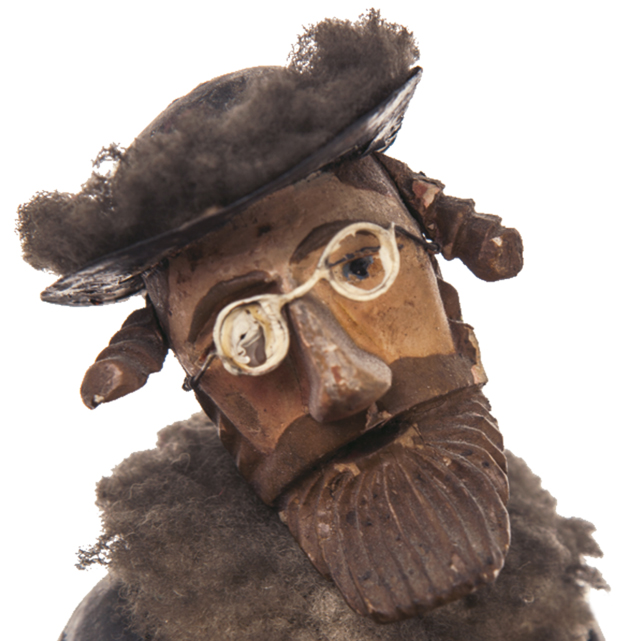Fortune and misfortune are neighbors.
– German proverb
A tiny Jewish head, wearing a fur-trimmed hat, rolled across the lace tablecloth in a Kraków apartment. It was stopped by a pack of Marlboros. The gaze pointed toward a disjoined arm. A miniature hand clutched a curling scrap of Torah parchment lined with painstakingly flourished Hebrew letters. Assembled, the figurine stood about five inches tall on springed legs. I touched it. It shokled, rocking in the characteristic posture of Jewish prayer.
As an anthropologist and the child of a Jewish refugee from Nazi Europe, I had begun to interview carvers in the late 1990s in the context of my research on Poland’s Jewish heritage industry. I found my way to them mostly through shopkeepers who sold their wares; but one dear friend told me that his uncle used to make Jewish figurines. I asked if I could speak to him, and soon found myself at his dining room table, looking down at this disquieting array.
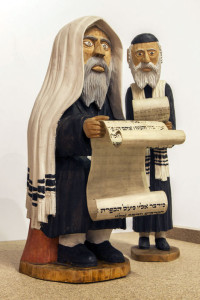
of authentic Torah parchment.
Bogusław Suwała, 1980s
Property of Danuta Suwała
Photo by Sebastian Molski
In the 1960s, my friend’s carver uncle had discovered a Torah scroll hidden in the rafters of his father’s house. Not an uncommon find in postwar Poland, the scroll was stashed there during the war by a doomed Jewish neighbor. Over the years, the carver would clip small squares from the scroll and put them in the hands of his sculptures, the better they should pray. He remembered his Jewish neighbors: the nearby farmer and his geese, the fellow Boy Scout who shared Passover matzo with him. He stopped cutting the Torah scroll in the 1990s after an Israeli tourist told him he was doing something sacrilegious; by the time we met, he had turned to photocopying. Figurines in his personal collection still held the original Hebrew texts, often upside down. He chuckled softly: “I can never remember which way they go.”
It could be said that in Poland today there are more Jewish figurines than Jews; indeed, most people living in Poland have never met a Jew. But nowadays, Poles live in towns and cities where Jews once made up 30% or more of the population. In many places, not a trace is left of the Jewish communities that once lived there. That blank space is filled today with images of Jews: figurines, pictures, magnets, postcards, and more. “Lucky Jews”—figurines and images of Jews holding money—have proliferated with particular potency in Poland along with the country’s transition to capitalism. These good luck charms hang in homes and sit by cash registers in shops and restaurants across the country. In the context of debates about Polish complicity in Holocaust and post-Holocaust violence against Jews, and with a new influx of foreign Jews “returning” to Poland in a surge of secular pilgrimage, they have become a source of controversy.
On my journeys to Poland in the last two decades—part scholarly inquiry, part personal quest—the figurines have been a constant companion. They bear burdens disproportionate to their small size. To an outsider’s eye, especially a Jewish one, their negative valences can be painfully obvious. They are easy to dismiss as material manifestations of Polish antisemitism. Not only because they traffic in stereotypes, but also by the simple fact of them: little wooden Jews where so much flesh and blood once thrived. They got under my skin.
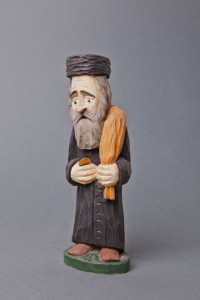
Zdzisław Błosiński (b. 1968), 2013
Authentic Polish handicraft certified by the National Artistic and Ethnographic Commission of the “Cepelia” Foundation.
Property of Erica Lehrer
Photo by Grzegorz Mart
I began seeking out their sources and tracing their travels. Who sold them? Who bought them? Why? And who made them? The figurines—with and without coins, church-fair toys and plaintive sculptures—showed up in the unlikeliest locations, with unexpected owners. In and around these objects unseen layers of cultural intimacy and emotion revealed themselves; they trade in timeworn stereotypes, but also carry traces of history, traumatic memory, and unspoken nostalgia for makers and buyers—Jews and non-Jews alike.
The Kraków hotel I stayed in for years turned out to have a life-sized wooden Jew playing a double bass tucked away behind the reception desk, and a portrait of a Jew counting money on the wall in the basement. A Warsaw butcher shop displayed a shochet (Jewish kosher butcher) figurine during the height of Poland’s 2013 dispute concerning a government ban on ritual slaughter. Wooden Jews stand watch over bathroom fixtures in a Warsaw hardware store, and Jew-with-a-coin portraits hang as décor suggestions in suburban home improvement megastores. I have seen them displayed in Polish homes among menorahs and Torah pointers, as well as alongside figurines of Jesus and medieval Polish knights. They mingle with imported kosher groceries in the Chabad-Lubavitch shop in Krakow’s Izaak synagogue, and by star-of-David pendants in the nearby Galicia Jewish Museum. I have also stumbled across them far from their birthplace, in Israeli, American, and Australian Jewish homes; on a scholar’s shelf between academic tomes in Hebrew; accompanying Polish-Jewish ancestors’ photos on a retirement community filing cabinet; by kiddush cups and sabbath candlesticks on a suburban credenza. I was surprised by the range of sentiments they evoked, even among their owners and creators.
The figurines are not a flash in the pan; no made-in-Taiwan bauble hot-stamped “Kraków” in place of “Rome” for a newly booming tourist market. Miniature Jews have deep roots in Polish culture—emerging in different forms over more than a century. They appeared alongside other local characters as puppets in pre-war Christian passion plays and as toys in Easter fairs, and later as secular sculptures sold in Cold War socialist folk art outlets. In the postwar era, they took on a de facto memorial quality when the Jews on which they were modeled had suddenly and violently disappeared. A checkered history underlies their newer forms and current popularity.
I came away from my search for figurines less sure of any singular meaning. Yet I was fascinated by what these small objects do. They not only separate, but connect Poles and Jews in ways not visible to the naked eye. They are instruments to express meanings, relationships, and emotions that find no other ready form or venue. They provoke the most various of reflections: A Polish Catholic woman told me that when the Nazis invaded in 1939, her father threw their Jewish figurines into the fire out of fear. A Jewish Holocaust survivor in Kraków commissioned figurines from a village carver as a corrective to those he saw as terribly stereotypical—though the distinction was lost on me. Conversations with Poles about the figurines in their homes led more than once to roundabout disclosures of their own Jewish roots.
Yet Jews and Poles each tend to understand the figurines only within their own familiar cultural framework, unaware of their meanings to the other. Jews wax nostalgic about a pre-war Jewish Poland that Tevye-and-Chagall-like fiddler figurines evoke, but cannot comprehend—or bristle at the thought—that Poles might do the same. And many Poles are simply puzzled that Jews, faced with figurines holding gold coins, see them as anything but an honorific: a celebration of Jewish entrepreneurship. Poles err by viewing the figurines naively, without reference to a long history of anti-Jewish imagery in which these objects inevitably partake; many Jews fail to see them as anything but antisemitism.
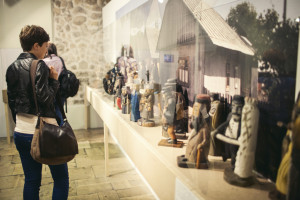
Given Poland’s complex and ultimately tragic Jewish history, one would hope that such potent, problematic objects would be treated thoughtfully in Polish museums—some of which have impressive collections of them. Yet they are presented disappointingly, naively: as part of a vanished village culture alongside painted eggs and Easter palm fronds; just one more curiosity of quaint Slavic peasant life, free from politics or the complex history of Polish-Jewish coexistence. The figurines’ increasingly vibrant presence–they are sold today in shops on the streets surrounding such museums–is also nowhere acknowledged.
So began my involvement as a student and curator of these provocative objects. I developed a museum exhibit—and eventually a book and website—that would present the figurines in a way that would evoke their historical complexity and “in-between” existence at the highly trafficked intersection of Polish, Jewish and also German cultures and communities—shaped today by a new social network of tourists, collectors, mourners, and devotees. I wanted to disrupt any simplistic or unitary view of their meaning, without neutralizing their disturbing qualities. In the exhibit I included a broad range of forms and genres of Poland’s Jewish figurines emerging from different historical moments and subcultural contexts, yet all extending into the present. My goal was to display these diverse objects side-by-side and pose questions about ethnic sameness and difference; intercultural connections and distance; continuity and change in images of other cultural groups, and the deep roots of present-day stereotypes. I also wanted visitors—Poles and Jews in particular—to reflect on their own habits of thought and perception.
Does the historically shifting array of miniature Jews represent an underlying continuity, and if so, does that say something essential and unchanging about how Poles see Jews? Are Jew-with-a-coin talismans an entirely distinctive phenomenon, or just a late-capitalist expression of an always-magical Jew? Do the echoes of medieval biblical aspersions or Nazi propaganda visible in some figurines—the hunched back, the hooked nose, the cloth sack with coins—mean that they are antisemitic, even if their owners insist they mean to honor Jewish entrepreneurship by displaying them? Do figurine makers today ply their trade exclusively for mercenary reasons? Are their customers unsophisticated and oblivious? Can these figurines mean whatever we want them to mean, or is history encoded in their very forms? I tried to arrange the exhibit to confront viewers with these questions, and challenged them to formulate their own answers.
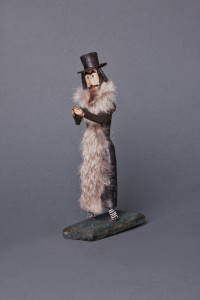
Kraków, Małopolskie province, 19th-20th c.
Wood, fur, wire, cardboard; overall height 23 cm; stand: 12 x 6 cm
Owned by: Seweryn Udziela Ethnographic Museum, Kraków
(inventory no.: 27624/MEK)
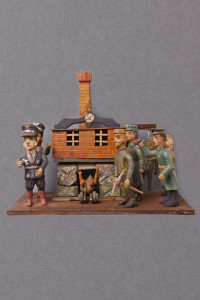
Jan Wojtarowicz (1895–?)
1970
Property of Marian Pokropek
Folk Art Museum in Otrębusy
Photo by Grzegorz Mart
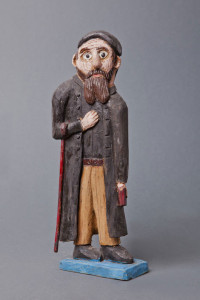
Jan Malik, 1970s
Property of Leszek Macak
The role of curator offered wonderful possibilities for such productive provocation. Juxtaposing the venerable Polish “pensive Christ” with a similarly thoughtful everyday Jew suggested one artist’s meditation on common religious roots. As the matching profiles of an everyday Jew and a bishop figurine made by a single carver of Emaus Easter toys reveal, in this particular case there was no distinct Jewish caricature; both figures sway and bobble in a shared technology of amusement. And the pairing of carver Maciej Manowiecki’s capote-and-tallit-wearing Jew with his similarly black-and-white penguin is at once a humorous and unsettling commentary on the place of the Jew in the ecosystem of tourist tchotchkes.
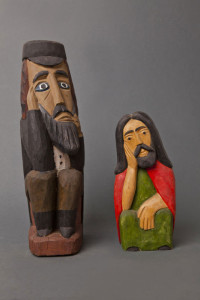
Pensive Jew, Adam Zegadło, 1970 (left)
Property of Leszek Macak
Sorrowful Christ, Marian Adamski, date unknown, (right)
Property of Marian Pokropek, Folk Art Museum in Otrębusy
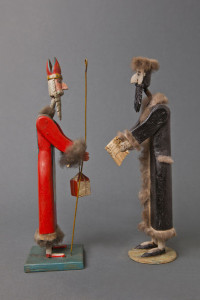
Property of Leszek Macak
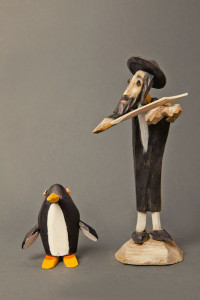
Maciej Manowiecki
2013
Property of Erica Lehrer
Grouping together a wide array of postwar sculptures highlights both their individual and their mythical characteristics: the frequency with which figurines display hunchbacks, for example, reflects Christian cosmology’s equating of Jewishness with moral failing, rather than neighborly observation. A 19th-century figural beehive in the shape of a Hasid prompts us to set today’s plasticine souvenirs in a broader sweep of folk expression.

Zabierzów late 19th c.
Collection of the Seweryn Udziela Ethnographic Museum in Kraków
Traditional texts illustrate how the stereotype of the Jew as visualized in material form is reinforced in language—written, spoken, and sung. Józef Reguła’s bas-reliefs based on Jewish jokes are one such illustration, as are traditional lyrics from the “Herods” or Christmas crèche plays in which the Jew is a central character. The centuries old traditional text—reproduced here in a 2013 version from a Polish cultural revitalization project—illustrates both the physical and character traits associated with the Jew, as well as the undercurrents of violence that both threatened and perhaps continue to threaten him.
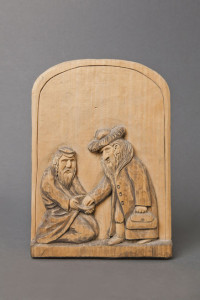
Józef Reguła, 1992
In his early experiments with form and content, Józef Reguła carved a series of reliefs based on entries from a book of Jewish jokes. The jokes are written on the backs of the carvings.
Property of Józef Reguła
The figurines are vastly enriched when we appreciate them as the product of individual human hands. Viewing them alongside the voices of their makers can be inspiring but also troubling, revealing motivations both profound and superficial. Numerous times I heard Jews say that a Jewish person would never make such a figurine; in response, I included Jewish figurines from the U.S. and Israel that belie that notion. And for good measure, I added African-American and Native American figurines from North America to remind Western and New World critics that those who would point fingers have their own landscape of painful ethnic “memorabilia” to face.
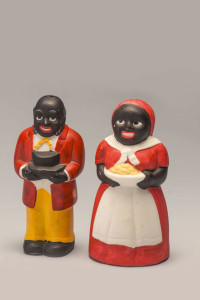
Salt and pepper shaker set, circa 2000s (reproduction)
Photo by FSU Photographic Services
Property of Erica Lehrer
The exhibit catalyzed some of the discussions I had hoped for. In the gallery question books, people described their shock at confronting the figurines en masse; some expressed distress while watching video clips of casually antisemitic comments made by Polish collectors, and others dismissed my critical approach entirely, seeing in it evidence of typical Jewish self-obsession and oversensitivity. For the companion book, I commissioned short essays by Polish intellectuals, who treated the figurines from a range of viewpoints; some highlighting the failings of Polish national self-scrutiny in the aftermath of the Holocaust, some the ways in which unresolved Jewish historical trauma or cultural anxieties may color our perceptions of them.
Ultimately, I hope Lucky Jews establishes that Poland’s Jewish figurines represent a special kind of “post-Jewish” cultural fragment, worthy of sustained consideration, and that museums should be leaders in cultural criticism by leveraging the difficult histories hidden in their own collections. In contrast to the domestic objects, buildings, or cemeteries left behind by this destroyed community, the figurines testify not only to centuries-long Jewish presence in Polish lands, but also the central place Jews continue to play in Polish collective consciousness. While they may embody pernicious cultural stereotypes, these figurines are also a wordless working through of history’s wounds—linking debates about the difficult past and the everyday present in our homes, shops, and streets.
Visit the accompanying website: www.luckyjews.com
- Lucky Jews - June 5, 2015


